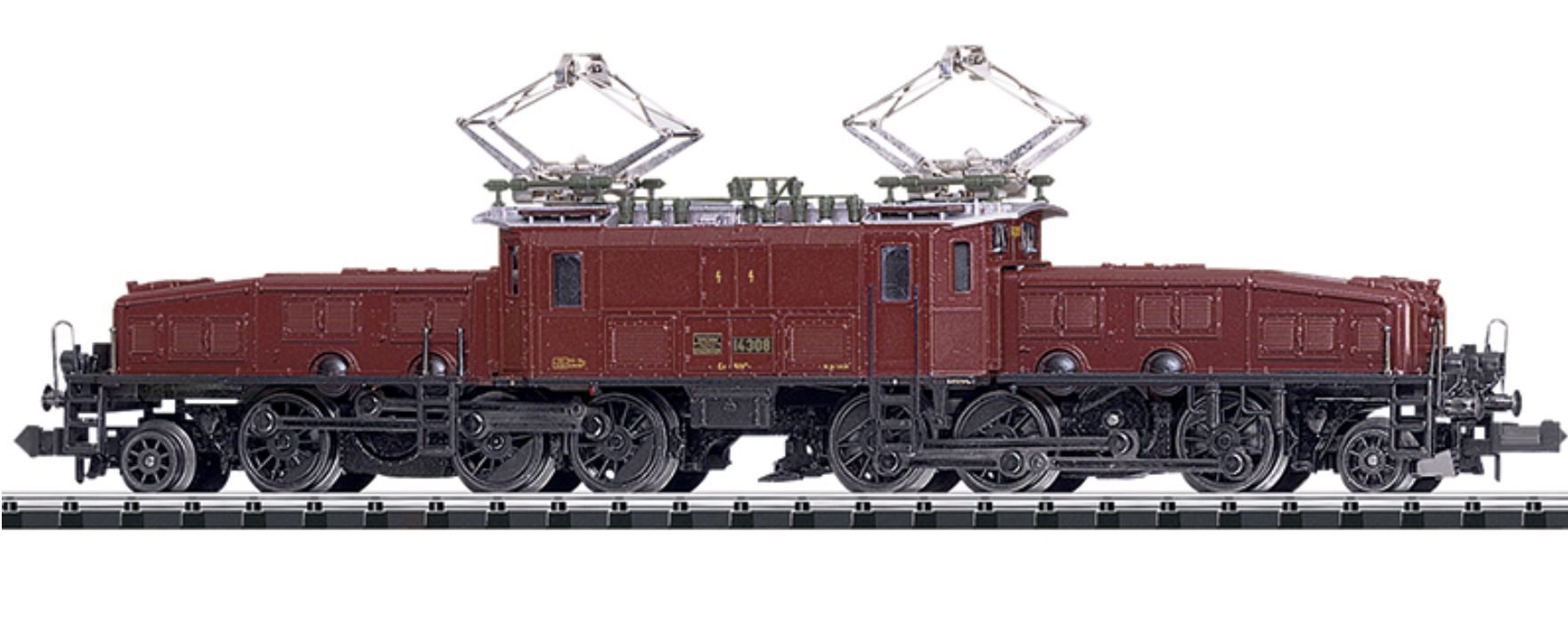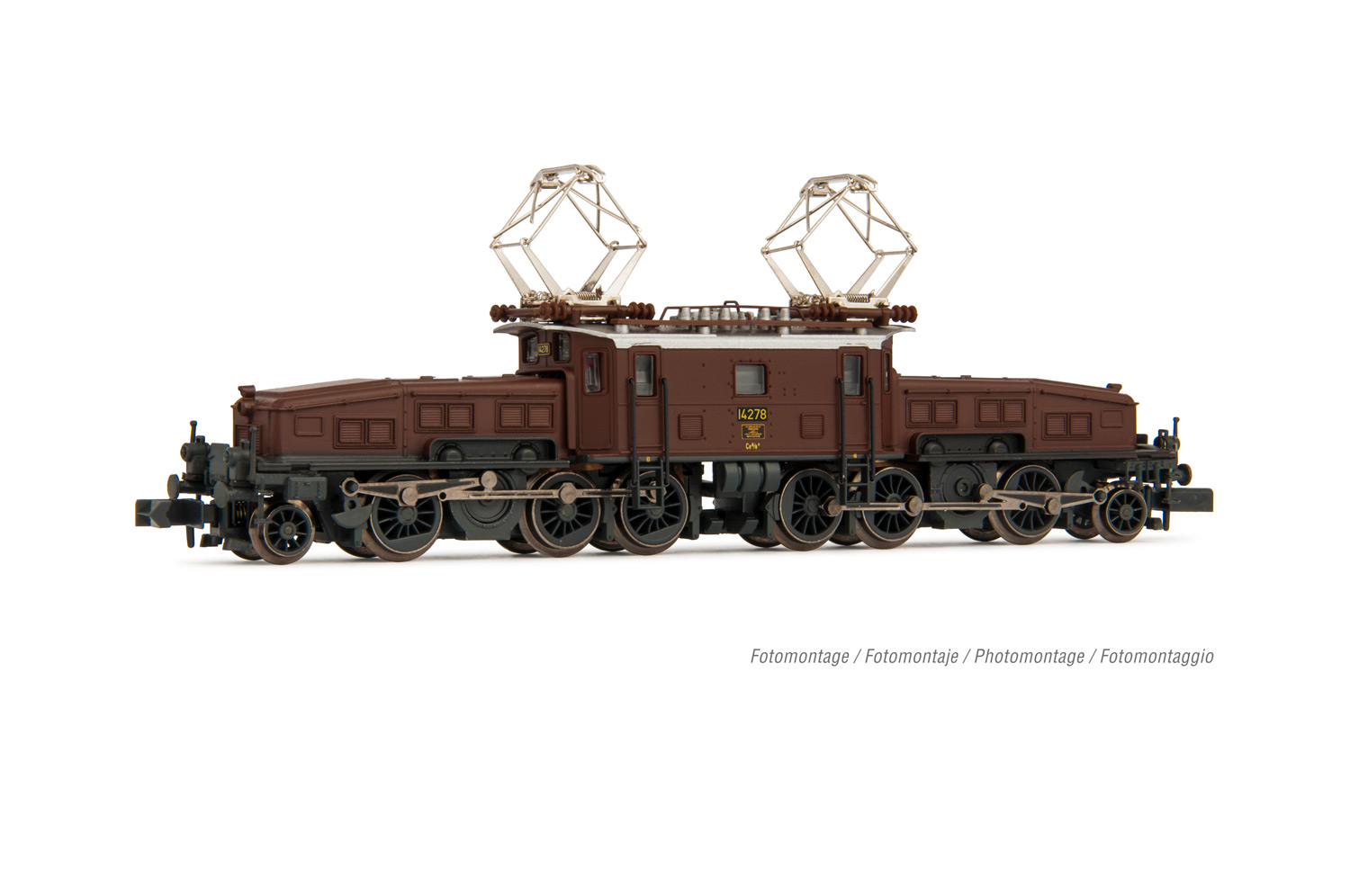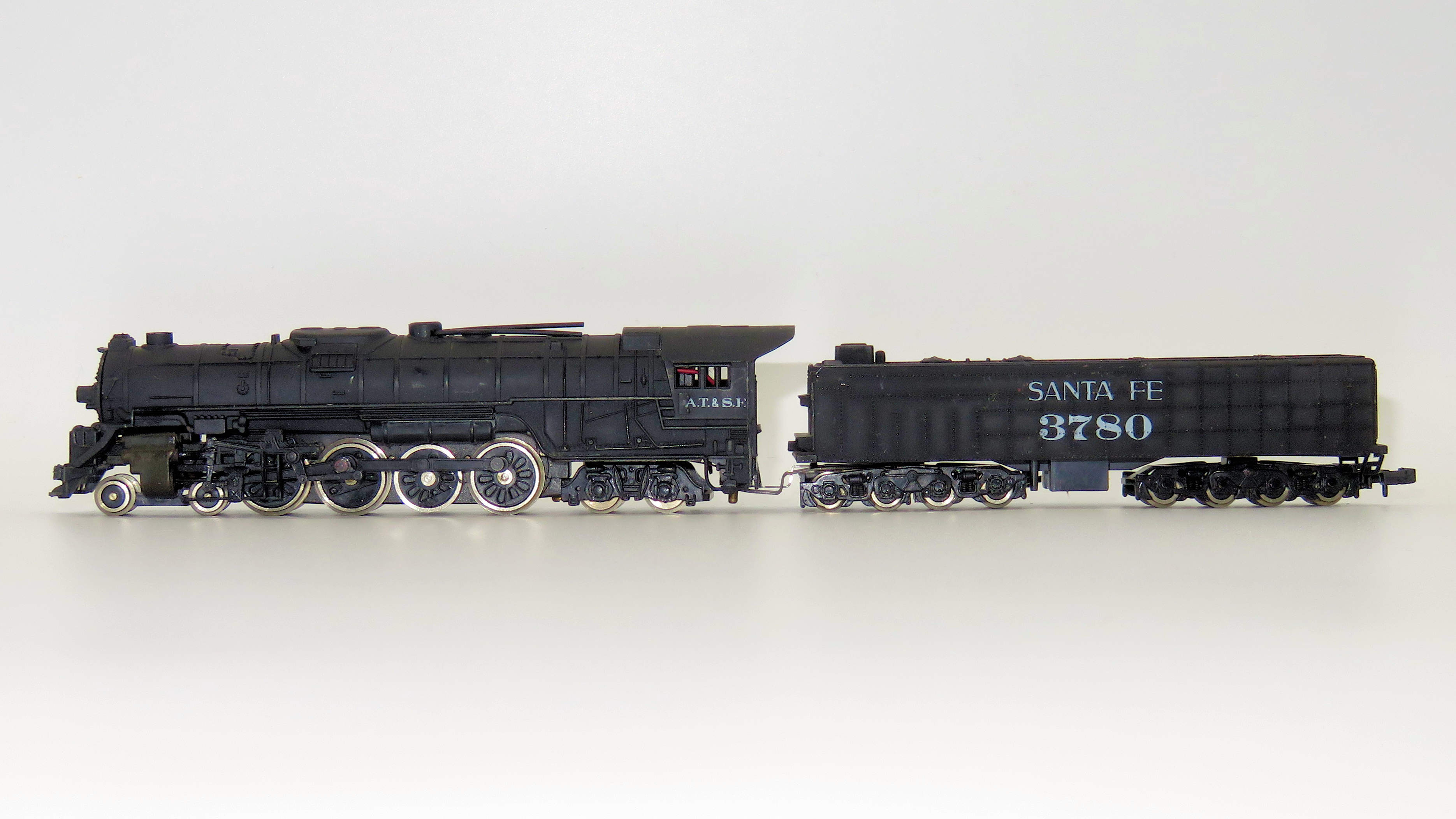Specific Item Information: Swiss Federal Railways (SBB) class Ce 6/8 III. Design with diagonal side rod drive. Built starting in 1926. World famous electric locomotive type, nicknamed "Crocodile".
Prototype History: Crocodile (German Krokodil) electric locomotives are so called because they have long "noses" at each end, reminiscent of the snout of a crocodile (see also Steeplecab). These contain the motors and drive axles, and are connected by an articulated center section. The center section usually contains the crew compartments, pantographs and transformer.
A prototype locomotive, SBB-CFF-FFS Ce 6/8 I number 14201, was ordered in June 1917. The production "Crocodiles" were the series SBB Ce 6/8 II and SBB Ce 6/8 III locomotives of the SBB, Swiss Federal Railways, built between 1919 and 1927. There were 33 class Ce 6/8 II and 18 class Ce 6/8 III, making a total (excluding the prototype) of 51 locomotives. These locomotives were developed for pulling heavy goods trains on the steep tracks of the Gotthardbahn from Lucerne to Chiasso, including the Gotthard Tunnel.
The electric motors available at the time were large and had to be body-mounted above the plane of the axles, but flexibility was required to negotiate the tight curves on the Alpine routes and tunnels. An articulated design, with two powered nose units bridged with a pivoting center section containing cabs and the heavy transformer, met both requirements and gave excellent visibility from driving cabs mounted safely away from any collision. The two motors in each nose unit were geared to a jackshaft between the drive axles farthest from the cab, with side rods carrying the power to the drivers. These locomotives, sometimes called the "Swiss Crocodile" or "SBB Crocodile", were highly successful and served until the 1980s. Märklin published a book about their history in 1984. Several are still in operation as preserved historical locomotives.
From Wikipedia
A prototype locomotive, SBB-CFF-FFS Ce 6/8 I number 14201, was ordered in June 1917. The production "Crocodiles" were the series SBB Ce 6/8 II and SBB Ce 6/8 III locomotives of the SBB, Swiss Federal Railways, built between 1919 and 1927. There were 33 class Ce 6/8 II and 18 class Ce 6/8 III, making a total (excluding the prototype) of 51 locomotives. These locomotives were developed for pulling heavy goods trains on the steep tracks of the Gotthardbahn from Lucerne to Chiasso, including the Gotthard Tunnel.
The electric motors available at the time were large and had to be body-mounted above the plane of the axles, but flexibility was required to negotiate the tight curves on the Alpine routes and tunnels. An articulated design, with two powered nose units bridged with a pivoting center section containing cabs and the heavy transformer, met both requirements and gave excellent visibility from driving cabs mounted safely away from any collision. The two motors in each nose unit were geared to a jackshaft between the drive axles farthest from the cab, with side rods carrying the power to the drivers. These locomotives, sometimes called the "Swiss Crocodile" or "SBB Crocodile", were highly successful and served until the 1980s. Märklin published a book about their history in 1984. Several are still in operation as preserved historical locomotives.
From Wikipedia
Road Name History: Swiss Federal Railways (German: Schweizerische Bundesbahnen (SBB), French: Chemins de fer fédéraux suisses (CFF), Italian: Ferrovie federali svizzere (FFS)) is the national railway company of Switzerland. It is usually referred to by the initials of its German, French and Italian names, either concatenated as SBB CFF FFS, or used separately.
The company is headquartered in Bern.
Read more on Wikipedia.
The company is headquartered in Bern.
Read more on Wikipedia.
Brand/Importer Information: Trix is a German company that originally made Trix metal construction sets. one of its co-founders was Stephan Bing, the son of the pioneer toy-maker industrialist Ignaz Bing. In 1935 the company began producing the electrically powered model trains that it became famous for, under the Trix Express label. Prior to the outbreak of World War II the Trix company produced a small range of fairly unrealistic AC powered three rail models running at 14 volts.
N gauge models under the Minitrix brand were made from the late 1960s mostly of European prototypes (German and British primarily). North American prototypes were also manufactured and marketed under the Aurora "Postage Stamp" brand; later these items were sold under the American Tortoise, Model Power and Con-Cor brands. Trix sometimes utilized North American consultants to aid in the design of this portion of the product line. The "Hornby Minitrix' brand was used in the 1980s for a short lived range of British outline models using the earlier product tooling.
Trix's owner in the 1980s and 1990s was Mangold, which went bankrupt in the late 1990s and Märklin purchased the assets in January 1997. In part, this purchase was a reflection of Märklin's need for added production capacity; Trix had been manufacturing certain items for Märklin in previous years. The purchase was also in response to the earlier purchase of the Karl Arnold company by the Italian company Rivarossi; Märklin were very keen to take over Trix market share in 2-rail H0 and especially Minitrix, until then Märklin had not marketed N gauge models. In 2003, Märklin introduced its first N gauge models under the well established Minitrix brand. A number Märklin H0 scale three-rail AC locomotives have also been introduced in two-rail DC versions under the Trix logo and many models are shared between the two brands.
From Wikipedia
N gauge models under the Minitrix brand were made from the late 1960s mostly of European prototypes (German and British primarily). North American prototypes were also manufactured and marketed under the Aurora "Postage Stamp" brand; later these items were sold under the American Tortoise, Model Power and Con-Cor brands. Trix sometimes utilized North American consultants to aid in the design of this portion of the product line. The "Hornby Minitrix' brand was used in the 1980s for a short lived range of British outline models using the earlier product tooling.
Trix's owner in the 1980s and 1990s was Mangold, which went bankrupt in the late 1990s and Märklin purchased the assets in January 1997. In part, this purchase was a reflection of Märklin's need for added production capacity; Trix had been manufacturing certain items for Märklin in previous years. The purchase was also in response to the earlier purchase of the Karl Arnold company by the Italian company Rivarossi; Märklin were very keen to take over Trix market share in 2-rail H0 and especially Minitrix, until then Märklin had not marketed N gauge models. In 2003, Märklin introduced its first N gauge models under the well established Minitrix brand. A number Märklin H0 scale three-rail AC locomotives have also been introduced in two-rail DC versions under the Trix logo and many models are shared between the two brands.
From Wikipedia
Item created by: CNW400 on 2022-05-27 11:08:10
If you see errors or missing data in this entry, please feel free to log in and edit it. Anyone with a Gmail account can log in instantly.
If you see errors or missing data in this entry, please feel free to log in and edit it. Anyone with a Gmail account can log in instantly.











